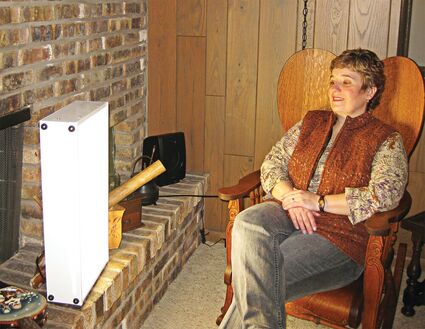Combating Seasonal Affective Disorder before it starts
October 1, 2022 | View PDF

Alaska Northern Lights photo
Today's SAD lights come in a wide variety of shapes and sizes, and are utilized in different ways. In general, lights should be UV-free and a minimum brightness level of 10,000 lux.
Combating seasonal affective disorder (SAD) requires a multi-prong approach that may include light therapy, psychotherapy, antidepressant medications, or vitamin D. Known as "the winter blues," Alaskans face the highest risks due to a lack of light in the winter and now is when treatment needs to begin.
In most cases, SAD symptoms start in the late fall or early winter and go away during the spring and summer. This is known as winter-pattern SAD, or winter depression. Some adults may experience depressive episodes during the spring and summer months, which is known as summer-pattern SAD or summer depression.
SAD is considered a type of depression characterized by its recurrent seasonal pattern, with symptoms lasting about four to five months every year. The signs and symptoms of SAD include those associated with major depression, and some specific symptoms that differ for winter-pattern and summer-pattern SAD.
"While light therapy is an easy way to treat SAD, there are also other things we can do in our daily lives that can help combat symptoms. Exercising daily causes a release of endorphins that helps give us the energy needed to get us through the day without needing a nap," said Beth Kusiak, who is with Alaska Northern Lights, a Nevada-based manufacturer of SAD lights.
Cognitive Behavioral Therapy (CBT) is one of the most well-known treatments for seasonal depression and it involves talk therapy where the therapist and client work together to develop a plan for dealing with SAD. CBT typically is conducted in two weekly group sessions for six weeks and focuses on replacing negative thoughts related to the winter season with more positive thoughts. It also uses a process called behavioral activation, which helps individuals identify and schedule pleasant, engaging indoor or outdoor activities to combat the loss of interest they typically experience in the winter.
"Another great way to deal with SAD is with the food that we eat. Avoiding a diet that is high in sugar, caffeine and alcohol can help reduce the symptoms of seasonal depression. Eating things like fresh fruits and vegetables, lean proteins and foods that have lots of Omega-3 fatty acids, like salmon, walnuts and flax seeds, can also help keep our bodies healthy and our minds happy," Kusiak said.
Does light therapy work?
Light therapy since the 1980s has been a mainstay for the treatment of SAD and it is one of the easiest ways to treat SAD. All you have to do is sit in front of a 10,000 LUX light therapy device for about 30 minutes each morning.
"You do not need to stare into the light or hold the device directly in front of your face," said Kusiak. "You can be watching TV, reading, eating breakfast, answering emails, while getting the benefits of light therapy."
When the light enters through the eyes, it causes a chemical reaction in the brain and starts producing serotonin. Kusiak said serotonin is what provides a person with energy and lifts mood. Having this chemical released around the same time every morning can also help set your circadian rhythm to correct any sleep cycle issues.
You do need to be picky when it comes to light therapy devices. Kusiak said the light should be completely UV-free. Any light that will be shining on your face and eyes cannot have any UV emitted because it can cause serious damage over time.
"The device should emit 10,000 LUX. This is the amount of light that is needed to efficiently produce enough serotonin to get you through the day. With a light that emits 2,500 to 5,000 LUX, you will not be getting enough of a chemical reaction to get the level of serotonin that is needed," Kusiak said.
Make sure the light can be used at a good distance. There are many light therapy devices that may claim to provide 10,000 LUX, but require being at a distance of 8 to 12 inches from your face.
"With that close of a distance, you would need to hold the light in front of you for the duration of the session. This would not be comfortable or convenient," Kusiak said.
Making sure that light therapy devices are effective at a convenient distance can allow you to comfortably set the device on a table, desk or countertop and still have enough space to eat, read or use a keyboard.
"Getting ahead of SAD can help lessen the symptoms. We usually recommend for anyone that suffers from SAD to start using light therapy at least two weeks before their symptoms usually appear. Most customers that we talk to tend to start feeling symptoms in late September or early October," Kusiak said.
Many people may be buying lights to treat SAD on the internet, where there are cadres of hucksters preying on older adults.
"It's important to be wary of gadgets and gimmicks on the internet claiming to prevent or reduce the impact of SAD. People should consult with their healthcare provider about the treatment that is most appropriate for them," said psychiatrist Dr. Jeffrey Borenstein, president and CEO of the Brain and Behavior Research Foundation.
Resetting your biological clock
Both serotonin and melatonin help maintain the body's daily rhythm that is tied to the seasonal night-day cycle. With SAD, the changes in serotonin and melatonin levels disrupt the normal daily rhythms. Deficits in vitamin D may exacerbate these problems; vitamin D is believed to promote serotonin activity.
Because many people with SAD often have vitamin D deficiency, nutritional supplements of vitamin D may help improve their symptoms. However, studies testing whether vitamin D is effective in SAD treatment have produced mixed findings, with some results indicating that it is as effective as light therapy but others detecting no effect.
When researchers directly compared CBT with light therapy, both treatments were equally effective in improving SAD symptoms. Some symptoms seemed to get better a little faster with light therapy than with CBT. However, a long-term study that followed SAD patients for two winters found that the positive effects of CBT seemed to last longer over time.
Medications
Because SAD, like other types of depression, is associated with disturbances in serotonin activity, antidepressant medications called selective serotonin reuptake inhibitors (SSRIs) are also used to treat symptoms. These agents can significantly enhance patients' moods. Commonly used SSRIs include fluoxetine, citalopram, sertraline, paroxetine and escitalopram. The U.S. Food and Drug Administration (FDA) also has approved another type of antidepressant, bupropion, in an extended-release form, that can prevent recurrence of seasonal major depressive episodes when taken daily from the fall until the following early spring.
"People who are experiencing symptoms of SAD should begin treatment as soon as possible in consultation with their healthcare provider," said Dr. Borenstein. "The most important take-home message is that SAD, just like other types of depression, is treatable and people should not suffer in silence. They should seek help."
Do I have Seasonal Affective Disorder?
Symptoms of Seasonal Affective Disorder may include feeling depressed most of the day, nearly every day, losing interest in activities previously enjoyed, and experiencing changes in appetite or weight. For many individuals, sleep problems are common along with feeling sluggish or agitated.
For winter-pattern SAD, symptoms may include oversleeping (hypersomnia), overeating, particularly with a craving for carbohydrates, weight gain, and social withdrawal. The depressive episodes tend to occur during the winter months for at least two consecutive years. However, not everyone with SAD experiences symptoms every year. SAD is much more common in women than in men, and it usually begins in young adulthood. SAD is more common in people with major depressive disorder or bipolar disorder.










